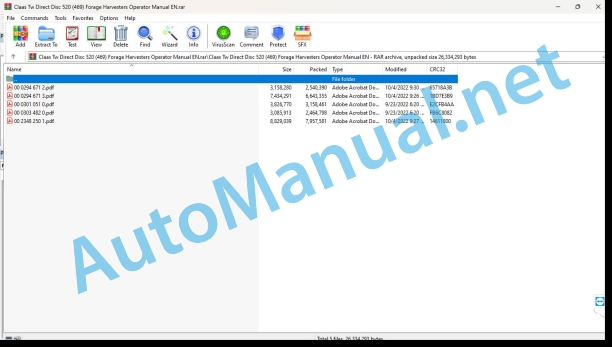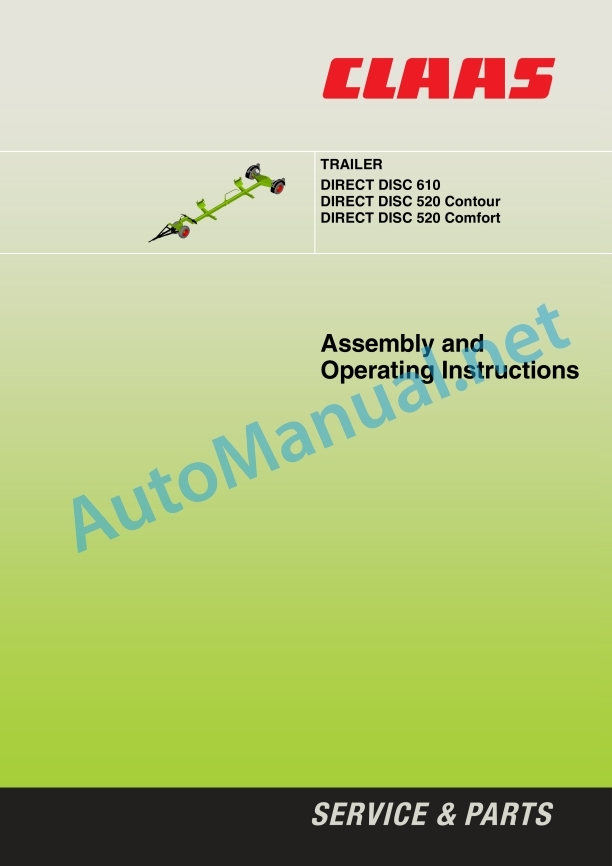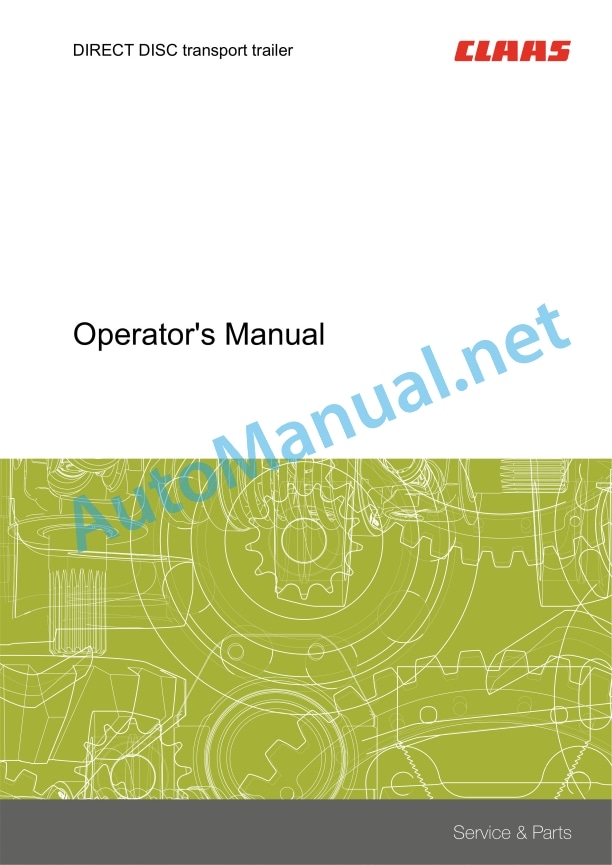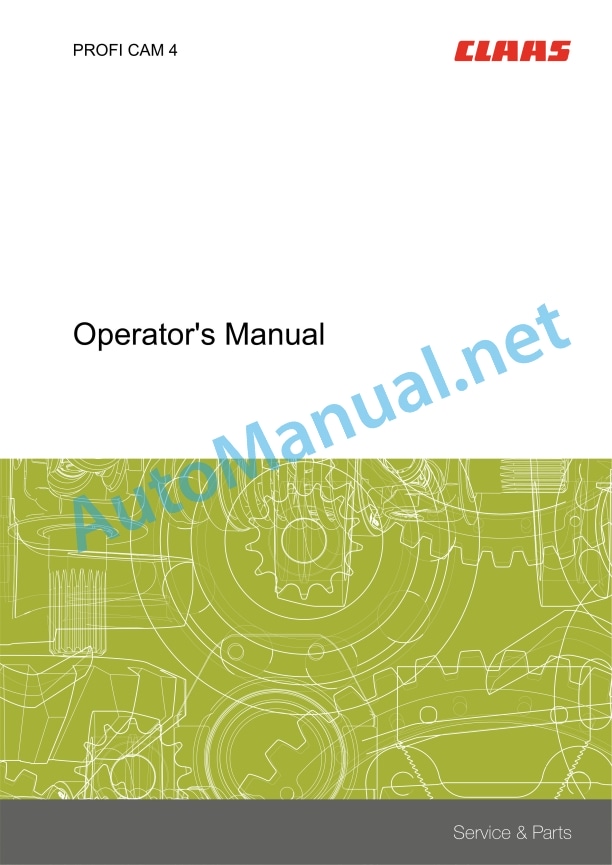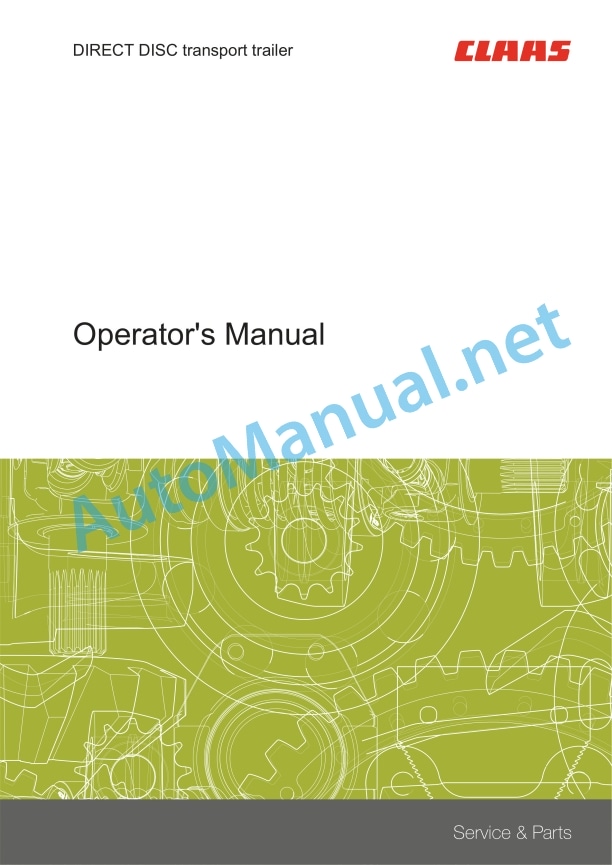Claas Tw Direct Disc 520 (469) Forage Harvesters Operator Manual EN
$50.00
- Model: Tw Direct Disc 520 (469) Forage Harvesters
- Type Of Manual: Operator Manual
- Language: EN
- Format: PDF(s)
- Size: 21.7 MB
File List:
00 0294 671 2.pdf
00 0294 671 3.pdf
00 0301 051 0.pdf
00 0303 482 0.pdf
00 2348 250 1.pdf
00 0294 671 2.pdf:
1 Machine overview
2 Introduction
Introduction
Validity
3 Contents
4 Preface
Of special importance
Identification plate
Road transport
Operating permit
Operating on public roads
Number plate
Regular inspection as required by law
5 Safety rules
Designated use
Identification of warnings and dangers
General Safety and Accident Prevention Instructions
Maintenance
Safety decals with warning symbols
6 Specifications
Trailer DIRECT DISC 610
Trailer DIRECT DISC 520
7 Assembly
Loading/unloading trailer
Assembling trailer
Check dimensions
8 Prior to operation
Check and observe the following before operation
9 Operation
Place the front attachment on the trailer
Removing the front attachment from the trailer
Hitching transport wagon
Unhitching transport wagon
Wheel chocks
10 Maintenance
Important Maintenance Instructions
Wheels / tyres
Brakes and axles
Fasteners
Lubrication
Braking system
General information
Function of reverse automatic system
Operating and handling
Setting the wheel brakes
Basic setting of the wheel brakes
Basic setting of the wheel brakes front
Basic setting of the wheel brakes rear
Maintenance intervals
After 50 operating hours
Every 200 operating hours
Every 250 operating hours
Problems and their possible causes
Wheel changing
Adjusting taper roller bearing
Fasteners
Screw connections
Cleaning and care
End of season storage
Lubrication chart
11 Lubrication Chart
Safety rules
Lubricants
Lubrication
00 0294 671 3.pdf:
DIRECT DISC transport trailer
Table of contents
Introduction
Notes on the manual
Validity of the manual
Information about this Operator’s Manual
Symbols and notes
Qualified specialist workshop
Notes on maintenance
Notes on warranty
Spare parts and technical questions
Intended use
Intended use
Reasonably foreseeable misuse
Identifying warnings
Hazard signs
Signal word
Safety rules
Meaning of Operator’s Manual
Observing safety decals and warnings
Requirements for all persons working with the machine
Hazard areas
Coupling of machine with front attachment or transport trailer
Structural changes
Optional equipment and spare parts
Technical condition
Keeping the safety devices functional
Personal protective equipment
Wearing suitable clothing
Removing dirt and loose objects
Parking the transport trailer safely
Unsuitable operating materials
Safe handling of operating and auxiliary materials
Environmental protection and disposal
Fire hazard
Maintenance operations and repair work
Safety marking
Layout of safety decals
Safety decals on the transport trailer
Official licence plate
Machine description
Overview and method of operation
Overview of transport trailer
Function of transport trailer
Identification plates and identification numbers
Transport trailer identification plate
Automatic overrun brakes identification plate
Information on the machine
Decal on transport trailer
Operating and display elements
Controls
Retainers
Technical specifications
Transport trailer
Dimensions
Tyres and tyre pressure
Operating utilities
Lubricants
Machine preparation
Unhitching and securing the transport trailer
Unhitching and securing the transport trailer
Assembling the transport trailer
Fitting the orientation aid
Installing the retainers
Fitting the lighting cable
Installing the contact-breaking cable
Adapting the transport trailer
Adapting the retainer to the front attachment
Checking the position of supports
Hitching the transport trailer
Hitching the drawbar
Connecting the lighting
Connecting the contact-breaking cable
Removing the wheel chocks
Releasing the parking brake
Unhitching the transport trailer
Applying the parking brake
Positioning the wheel chock at the wheel
Separating the contact-breaking cable
Disconnecting the lighting
Unhitching the drawbar
Loading the transport trailer
Lifting the transport trailer
Operation
Driving on the road
Driving on public roads
Loading the transport trailer
Placing the front attachment on the transport trailer
Unloading the transport trailer
Lifting the front attachment off the transport trailer
Faults and remedies
Overview of problems
Problems with the transport trailer
Changing the wheel
Maintenance
Service interval overview
Before the harvest
After the first 10 operating hours
After the first 50 operating hours
Every 50 operating hours
Every 250 operating hours
After the harvest
Checking the tyre air pressure
Retightening the wheel nuts
Checking the wheel hub bearing play
Adjusting the wheel hub bearing play
Carrying out a functional check of the brake system
Carrying out a visual inspection of the brake
Checking the adjustment of the wheel brake
Checking the parking brake adjustment
Electrical and electronic system
Checking the lighting
Checking the frame mounting
Assembly parts and bodywork
Checking the wheel chocks
Cleaning the transport trailer
Preserving the transport trailer
Check the fittings
Lubrication plan
Lubricating grease points every 250 operating hours
Putting out of operation and disposal
General information
Removal from service and disposal
EC declaration of conformity
Transport trailer
EC Declaration of Conformity
Technical terms and abbreviations
Terms and explanations
Abbreviations
00 0301 051 0.pdf:
PROFI CAM 3
Table of contents
1 Introduction
1.1 Notes on the manual
1.1.1 Validity of manual
1.1.2 Information about this Operator’s Manual
1.1.3 Symbols and notes
1.1.4 Optional equipment
1.1.5 Qualified specialist workshop
1.1.6 Maintenance information
1.1.7 Warranty notes
1.1.8 Spare parts and technical questions
1.2 Intended use
1.2.1 Intended use
1.2.2 Reasonably foreseeable misuse
2 Safety
2.1 Identifying warnings
2.1.1 Hazard signs
2.1.2 Signal word
2.2 Safety rules
2.2.1 Meaning of Operator’s Manual
2.2.2 Observing safety decals and warnings
2.2.3 Optional equipment and spare parts
3 Product description
3.1 Overview and method of operation
3.1.1 How the PROFI CAM works
3.2 Identification plates and identification number
3.2.1 Position of identification plates
3.2.2 Explanation of PROFI CAM identification plate
3.3 Information on the product
3.3.1 CE marking
4 Operating and control elements
4.1 Camera system
4.1.1 Camera system monitor
4.2 Menu structure
4.2.1 Main menu
4.2.2
4.2.3
4.2.4
4.2.5
4.2.6
5 Technical specifications
5.1 PROFI CAM
5.1.1 Monitor
5.1.2 Camera
5.1.3 Switch box
5.1.4 Degree of protection against foreign bodies and water
6 Preparing the product
6.1 Shutting down and securing the machine
6.1.1 Switching off and securing the machine
6.2 Prior to operation
6.2.1 Carry out prior to operation
6.2.2 Installing the sun protection
6.2.3 Aligning the camera
6.2.4 Connecting the camera electrics
7 Operation
7.1 Monitor
7.1.1 Switching on the monitor
7.1.2 Calling up the menu
7.1.3 Setting a menu item
7.1.4 Setting the image orientation
7.1.5 Setting automatic screen darkening
7.1.6 Image mirroring
7.1.7 Setting the trigger view
7.1.8 Setting the follow-up time for trigger view
7.1.9 Setting the display mode
7.1.10 Activating/deactivating a display mode
8 Faults and remedies
8.1 Electrical and electronic system
8.1.1 Overview of problems on PROFI CAM camera system
8.1.2 Replacing the switch box fuse
9 Maintenance
9.1 Maintenance intervals
9.1.1 Every 10 operating hours or daily
9.2 Camera system
9.2.1 Checking the camera system for dirt
9.2.2 Cleaning the camera
9.2.3 Cleaning the switch box
9.2.4 Cleaning the monitor
10 Placing out of operation and disposal
10.1 General Information
10.1.1 Putting out of operation and disposal
11 Technical terms and abbreviations
11.1 Abbreviations
11.1.1 Units
11.1.2 Abbreviations
11.1.3 Technical terms
00 0303 482 0.pdf:
PROFI CAM 4
Table of contents
1 Introduction
1.1 Notes on the manual
1.1.1 Validity of manual
1.1.2 Information about this Operator’s Manual
1.1.3 Symbols and notes
1.1.4 Optional equipment
1.1.5 Qualified specialist workshop
1.1.6 Maintenance information
1.1.7 Notes on warranty
1.1.8 Spare parts and technical questions
1.2 Intended use
1.2.1 Intended use
1.2.2 Reasonably foreseeable misuse
2 Safety
2.1 Identifying warnings
2.1.1 Hazard signs
2.1.2 Signal word
2.2 Safety rules
2.2.1 Meaning of Operator’s Manual
2.2.2 Structural changes
2.2.3 Optional equipment and spare parts
2.2.4 Operation only following proper putting into operation
2.2.5 Technical status
2.2.6 Respecting technical limit values
Respecting technical limit values
2.2.7 Hazards when driving on roads and fields
3 Product description
3.1 Overview and method of operation
3.1.1 How the PROFI CAM works
3.2 Identification plates and identification number
3.2.1 Identification plates
3.3 Information on the product
3.3.1 CE marking
4 Operating and display elements
4.1 Camera system
4.1.1 Camera system monitor
4.1.2 CEBIS
4.2 Menu structure
4.2.1 Main menu
4.2.2
4.2.3
4.2.4
4.2.5
4.2.6
5 Technical specifications
5.1 PROFI CAM
5.1.1 Monitor
5.1.2 Camera
5.1.3 Switch box
6 Preparing the product
6.1 Switching off and securing the machine
6.1.1 Switching off and securing the machine
6.2 Prior to putting into operation
6.2.1 Carry out prior to operation
6.2.2 Installing the sun protection
6.2.3 Aligning the camera
7 Operation
7.1 Monitor
7.1.1 Switching on the monitor
7.1.2 Calling up the menu
7.1.3 Setting a menu item
7.1.4 Setting the image orientation
7.1.5 Setting automatic screen darkening
7.1.6 Image mirroring
7.1.7 Setting the trigger view
7.1.8 Setting the follow-up time for trigger view
7.1.9 Setting the display mode
7.1.10 Activating/deactivating a display mode
8 Faults and remedies
8.1 Electric and electronic system
8.1.1 Overview of problems on PROFI CAM camera system
9 Maintenance
9.1 Maintenance intervals
9.1.1 Every 10 operating hours or daily
9.2 Camera system
9.2.1 Checking the camera system for dirt
9.2.2 Cleaning the camera
9.2.3 Cleaning the switch box
9.2.4 Cleaning the monitor
10 Putting out of operation and disposal
10.1 General information
10.1.1 Putting out of operation and disposal
11 Technical terms and abbreviations
11.1 Abbreviations
11.1.1 Units
11.1.2 Abbreviations
11.1.3 Technical terms
00 2348 250 1.pdf:
DIRECT DISC transport trailer
Table of contents
1 Introduction
1.1 Notes on the manual
1.1.1 Validity of the manual
1.1.2 Information about this Operator’s Manual
1.1.3 Symbols and notes
1.1.4 Qualified specialist workshop
1.1.5 Maintenance notes
1.1.6 Notes on warranty
1.1.7 Spare parts and technical questions
1.2 Intended use
1.2.1 Intended use
1.2.2 Reasonably foreseeable misuse
2 Safety
2.1 Identifying warnings
2.1.1 Hazard signs
2.1.2 Signal word
2.2 Safety rules
2.2.1 Importance of Operator’s Manual
2.2.2 Observing safety decals and warnings
2.2.3 Requirements for all persons working with the machine
2.2.4 Hazard areas
2.2.5 Fitting a front attachment or hitching a transport trailer to the machine
2.2.6 Structural alterations
2.2.7 Optional equipment and spare parts
2.2.8 Technical condition
2.2.9 Keeping safety devices functional
2.2.10 Personal protective equipment
2.2.11 Wearing suitable clothing
2.2.12 Removing dirt and loose objects
2.2.13 Parking the transport trailer safely
2.2.14 Unsuitable operating utilities
2.2.15 Safe handling of operating and auxiliary utilities
2.2.16 Environmental protection and disposal
2.2.17 Avoiding fires
2.2.18 Maintenance operations and repair work
2.3 Safety marking
2.3.1 Structure of safety decals
2.3.2 Safety decals on the transport trailer
2.3.3 Official licence plate
3 Machine description
3.1 Overview and method of operation
3.1.1 Overview of transport trailer
3.1.2 Function of transport trailer
3.2 Identification plates and identification numbers
3.2.1 Transport trailer identification plate
3.2.2 Identification plate of the axles
3.2.3 Automatic overrun brakes identification plate
3.3 Information on the machine
3.3.1 Decal on transport trailer
4 Operating and display elements
4.1 Controls
4.1.1 Retainers
5 Technical specifications
5.1 Transport trailer
5.1.1 Dimensions
5.1.2 Weight
5.1.3 Tyres and tyre pressure
5.2 Operating utilities
5.2.1 Lubricants
6 Machine preparation
6.1 Unhitching and securing the transport trailer
6.1.1 Unhitching and securing the transport trailer
6.2 Assembling the transport trailer
6.2.1 Fitting the orientation aid
6.2.2 Installing the retainers
6.2.3 Fitting the lighting cable
6.2.4 Fitting the chain with the padlock
6.3 Adapting the transport trailer
6.3.1 Adapting the retainer to the front attachment
6.3.2 Checking the position of supports
6.4 Hitching the transport trailer
6.4.1 Removing the chain with the padlock
6.4.2 Hitching the drawbar
6.4.3 Connecting the lighting
6.4.4 Connecting the contact-breaking cable
6.4.5 Removing the wheel chocks
6.4.6 Releasing the parking brake
6.5 Unhitching the transport trailer
6.5.1 Applying the parking brake
6.5.2 Positioning the wheel chock at the wheel
6.5.3 Separating the contact-breaking cable
6.5.4 Disconnecting the lighting
6.5.5 Unhitching the drawbar
6.5.6 Fitting the chain with the padlock
6.6 Prepare road travel
6.6.1 Performing checks prior to road travel
6.7 Loading the transport trailer
6.7.1 Lifting the transport trailer
7 Operation
7.1 Driving on the road
7.1.1 Driving on public roads
7.2 Loading the transport trailer
7.2.1 Placing the front attachment on the transport trailer
7.3 Unloading the transport trailer
7.3.1 Lifting the front attachment off the transport trailer
8 Faults and remedies
8.1 Overview of problems
8.1.1 Problems with the transport trailer
8.2 Chassis
8.2.1 Changing the wheel
9 Maintenance
9.1 Maintenance interval overview
9.1.1 Before the harvest
9.1.2 After the first 10 operating hours
9.1.3 After the first 50 operating hours
9.1.4 Every 50 operating hours
9.1.5 Every 250 operating hours
9.1.6 After the harvest
9.1.7 Every 2 years
9.2 Chassis
9.2.1 Checking the tyre air pressure
9.2.2 Retightening the wheel nuts
9.2.3 Checking the wheel hub bearing play
9.2.4 Adjusting the wheel hub bearing play
9.3 Brake
9.3.1 Carrying out a functional check of the brake system
9.3.2 Carrying out a visual inspection of the brake
9.3.3 Checking the parking brake adjustment
9.4 Electric and electronic system
9.4.1 Checking the lighting
9.5 Frame
9.5.1 Checking the frame mounting
9.6 Assembly parts and machine body
9.6.1 Checking the wheel chocks
9.6.2 Cleaning the transport trailer
9.6.3 Preserving the transport trailer
9.6.4 Check the fittings
9.7 Lubrication plan
9.7.1 Lubricating grease points every 250 operating hours
10 Putting out of operation and disposal
10.1 General information
10.1.1 Removal from service and disposal
11 EC declaration of conformity
11.1 Transport trailer
11.1.1 UK declaration of conformity
11.1.2 EC Declaration of Conformity
12 Technical terms and abbreviations
12.1 Terms and explanations
12.1.1 Abbreviations
John Deere Repair Technical Manual PDF
John Deere Repair Technical Manual PDF
John Deere POWERTECH E 4.5 and 6.8 L Diesel Engines TECHNICAL MANUAL 25JAN08
John Deere Repair Technical Manual PDF
John Deere Repair Technical Manual PDF
John Deere Repair Technical Manual PDF
John Deere Diesel Engines PowerTech 4.5L and 6.8L – Motor Base Technical Manual 07MAY08 Portuguese
John Deere Repair Technical Manual PDF
John Deere Repair Technical Manual PDF
John Deere Repair Technical Manual PDF
John Deere Transmission Control Unit Component Technical Manual CTM157 15JUL05
John Deere Repair Technical Manual PDF
John Deere Application List Component Technical Manual CTM106819 24AUG20
John Deere Repair Technical Manual PDF

